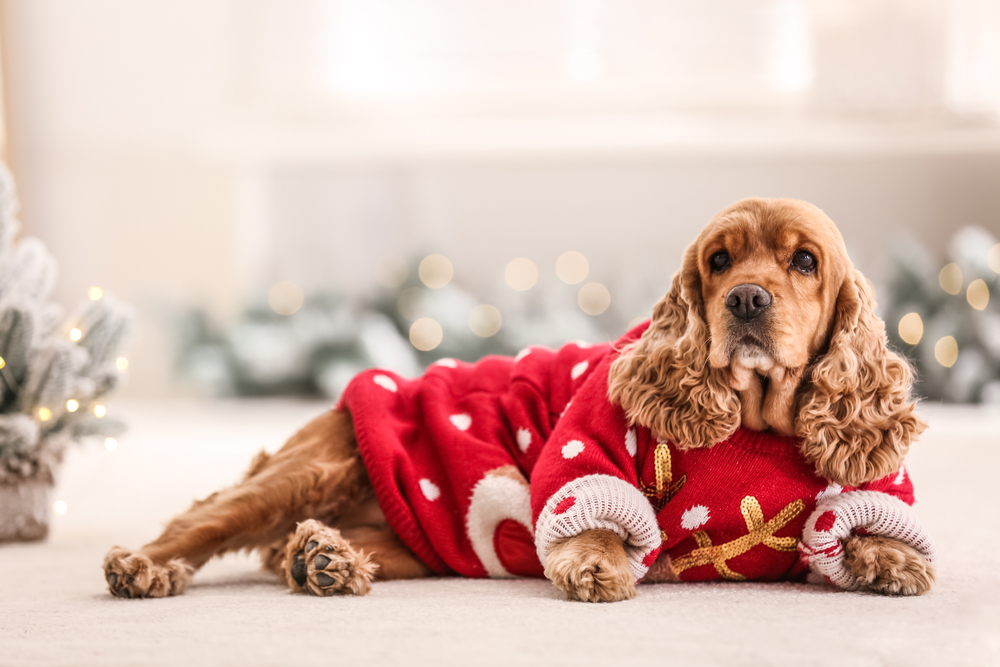Oh, the holiday season! It’s a time of joy and celebration, of feasting, family, and friends. It can also, however, present unique hazards for our furry friends. From tempting treats to festive decorations, here are some essential Christmas safety tips to keep your dog safe and happy during the holidays.

The 10 Vet-Reviewed Safety Tips for Spending Christmas with Dogs
1. Be Mindful About Meal Planning
Avoid feeding your dog table scraps or rich holiday foods. High-fat and high-sodium recipes can upset their stomachs or pose serious health risks. Keep chocolate, grapes, raisins, onions, garlic, and other toxic foods out of reach, as they can be harmful or even deadly to dogs.

2. Make Sure You Secure Your Tree
Anchor your Christmas tree securely to prevent it from toppling over if your dog decides to investigate or play nearby. Consider using a pet gate or barrier to restrict access to the tree when you’re not able to supervise.
3. Invest in Safe Decorations
Opt for pet-friendly decorations that are non-toxic and durable, such as shatterproof ornaments and unbreakable decorations. Avoid using tinsel, ribbon, and other small items that can be swallowed and cause digestive issues or blockages. Again, make sure your dog is always supervised when around the tree or the decorations.

4. Use Candles with Caution
Keep lit candles out of your dog’s reach to prevent burns or accidental fires. Consider using flameless LED candles as a safer alternative for decorating.
5. Educate Yourself on Electrical Safety
Secure electrical cords and wires to prevent your dog from chewing on them, which can result in electric shocks or injuries. Use cord covers or conceal cords behind furniture to minimize the risk of chewing.

6. Watch the Wrapping
Dispose of wrapping paper, ribbons, and packaging materials promptly to prevent your dog from ingesting them. Keep gift wrap supplies stored safely away from curious noses and paws.
7. Create Peaceful Spaces for Your Pup
Provide a quiet and comfortable space for your dog to retreat to when holiday festivities become overwhelming. Consider using calming aids, such as music, pheromone diffusers, or anxiety vests to help your dog relax.

8. Monitor Your Guests During Parties and Celebrations
Educate your guests about your dog’s needs and boundaries, especially if they’re not familiar with dogs or have allergies. Supervise interactions between your dog and guests, especially children, to prevent accidents or misunderstandings.
9. Take Precautions with Travel
If traveling with your dog during the holidays, ensure they are properly restrained in the car with a secure harness or crate. Pack familiar items, such as their favorite toys, bedding, and plenty of treats and food, to help your sweet pooch feel comfortable and secure in unfamiliar surroundings.

10. Be Prepared for Emergencies
Keep the contact information for your veterinarian and an emergency veterinary clinic handy in case of accidents or sudden illness. The holidays are often a time when the unexpected can happen. Familiarize yourself with the signs of common holiday hazards, such as chocolate poisoning or hypothermia, and know what to do in an emergency.
If you need to speak with a vet but can't get to one, head over to PangoVet. It's our online service where you can talk to a vet online and get the advice you need for your dog — all at an affordable price!

Conclusion
The holidays are a time of joy and connection, but they can also pose some hazards for your precious pets. By following these Christmas safety tips, you can enjoy the holiday season with more peace of mind, knowing that you’re keeping your canine companion safe from harm. With a little planning and vigilance, you can create a festive atmosphere for both you and your dog to enjoy together.
Featured Image Credit: New Africa, Shutterstock



















